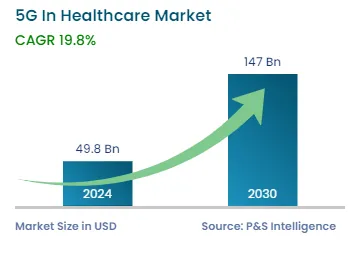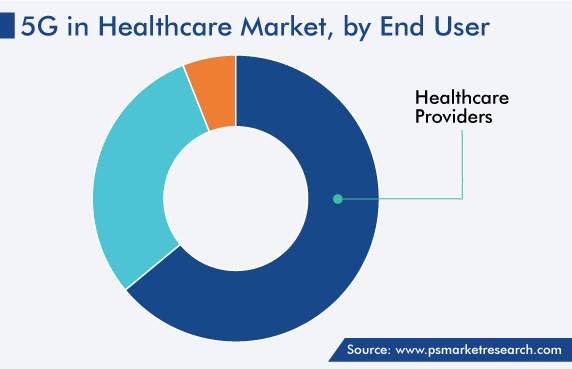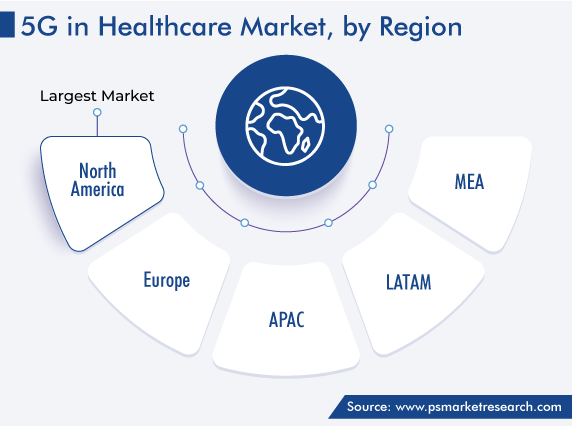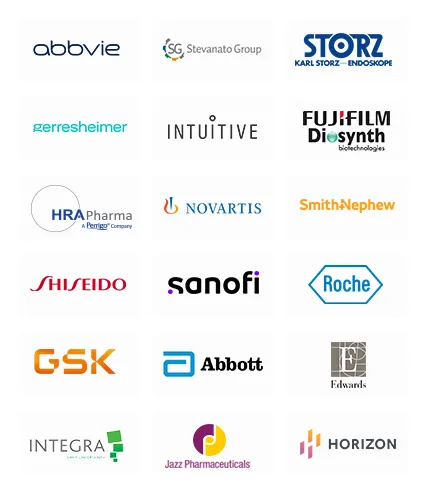Market Statistics
| Study Period | 2019 - 2030 |
| 2024 Market Size | USD 49.8 Billion |
| 2030 Forecast | USD 147 Billion |
| Growth Rate(CAGR) | 19.8% |
| Largest Region | North America |
| Fastest Growing Region | Asia-Pacific |
| Nature of the Market | Fragmented |
Report Code: 12582
Get a Comprehensive Overview of the 5G In Healthcare Market Report Prepared by P&S Intelligence, Segmented by Component (Hardware, Services), Application (Remote Patient Monitoring, Connected Medical Devices, AR/VR, Connected Ambulance, Asset Tracking), End-User (Healthcare Providers, Healthcare Payers), and Geographic Regions. This Report Provides Insights From 2019 to 2030.
| Study Period | 2019 - 2030 |
| 2024 Market Size | USD 49.8 Billion |
| 2030 Forecast | USD 147 Billion |
| Growth Rate(CAGR) | 19.8% |
| Largest Region | North America |
| Fastest Growing Region | Asia-Pacific |
| Nature of the Market | Fragmented |

Explore the market potential with our data-driven report
The global 5G in healthcare market was valued at USD 49.8 billion in 2024, and this number is expected to increase to USD 147 billion by 2030, advancing at a CAGR of 19.8% during 2024–2030. This can be attributed to the enhancing 5G infrastructure, growing healthcare sector, mounting number of launches of AR/VR devices for medical applications, increasing R&D investments by industry players, and surging demand for high-speed connectivity.
Moreover, the rising acceptance of robot-assisted surgeries, e-medicine, and wearable medical devices with high-speed connectivity is propelling the demand for this technology. This is because the low latency of this network can quicken the rate of surgeries and diagnoses, which would further help the market grow.
Rising Acceptance of E-Medicine and Robot-Assisted Surgeries Drives Market
ICTs have the potential to provide patient-centric care at a low cost, better the quality of care, enhance data sharing, advise medical professionals and patients on better treatment approaches, stimulate a different user interface with patients and medical care providers, and minimalize travel time.
Moreover, e-medicine and robot-assisted surgeries are now commonly being used since the pandemic over fears of cross-contamination between patients and surgeons. Telehealth needs a network that can support real-time high-quality audio and video, for which a faster network, i.e., 5G, for now, has become imperative. In this context, Ericsson mentioned in its report that it expects a USD 100,000 million revenue opportunity by 2026 for service providers addressing medical care transformation with 5G. The expected revenue can be derived from remote monitoring, virtual remote clinics, mHealth, and robotic surgeries.
Moreover, numerous nations have started supporting telehealth by offering reimbursement policies and adopting legal frameworks. For instance, the U.S. government is focused on untying the restrictions on e-medicine in the Medicare program, including allowing patients from any location to access such services from their homes. The U.S. Department of Health and Human Services (HHS) has waived off HIPAA implementation for telemedicine, while the Drug Enforcement Administration (DEA) has eased the requirements for the e-prescription of controlled substances.
The usage of telemedicine in the U.S. was minimal before COVID-19, but during the crisis, its implementation skyrocketed. Policymakers, insurers, and health systems have looked at alternative ways to deliver services to patients in their homes, to minimize the virus transmission. This has essentially driven the demand for 5G to support an efficient telemedicine service delivery.
The services category will register the higher growth rate during the forecast period, of around 19%. This will be due to the mounting demand for improved connectivity in medical devices for faster and more-reliable data transfer, which is enabled by the better-quality mobile broadband and higher frequency delivered by 5G services. In addition, the rising number of new entrants will play a vital role in the category’s growth.
The hardware category contributed the higher revenue in 2022, and it is further expected to maintain its dominance during the prediction period. This can be ascribed to the growing need for the replacement and upgradation of connected medical devices, to allow them to make the optimum use of advanced technologies, and rising requirement for high- or ultra-high bandwidths, low latency, and massive connectivity. Essentially, the increasing usage of the 5G technology for effective data transmission in telerobotic surgeries, telediagnosis, and wearable devices will contribute to the market growth.
Healthcare providers accounted for the largest revenue share, of 64%, in 2022, and this category is further expected to maintain its dominance in the coming years. This will be due to the growing pace of advancements in the healthcare industry, rising number of healthcare settings, such as hospitals and ASCs, mounting count of patients, rising need for e-medicine, burgeoning adoption of 5G-integrated wearable devices, and surging demand for enhanced technologies for the faster sharing and storage of large medical datasets.
Moreover, the healthcare payers category will witness significant growth in the coming years, ascribed to the burgeoning number of insurance and Medicare policyholders as well as insurance providers across all regions.

The connected medical devices category accounted for the largest revenue share, of around 44%, in 2022, and it is further expected to maintain its dominance in the coming years. This will be due to the growing trend of telemedicine, rising preference of patients for home-based care, mounting traction for personalized care, and increasing healthcare costs, as well as the growing focus of doctors on enhancing the quality of care and patient safety.
Moreover, such devices are widely used in real-time patient monitoring, to track the health status of patients and transmit the data to doctors. Hence, remote patient monitoring is gaining popularity nowadays, and it will witness fast growth in the coming years too. This Will be due to the surging health consciousness among individuals, burgeoning elderly population, mounting demand for remote health checkups, surging healthcare expenses, and increasing need for the effective delivery of chronic disease management and other medical services.
Furthermore, the category includes personal monitoring devices, which are used to collect patients’ health data; mobile applications that transmit this data to the healthcare provider; cloud databases that store the gathered information transmitted by remote patient monitoring devices, and hospital/clinic web applications, through which professionals analyze the data and prescribe medicines or share guidelines on the treatment. The whole process requires a high-speed and reliable network, such as 5G.
Drive strategic growth with comprehensive market analysis
North America accounted for the largest 5G in healthcare market revenue share, of 36%, in 2022, and it is further expected to maintain its position in the prediction period. This is due to the well-developed healthcare infrastructure, high per capita income, surging number of industry players, technological advancements, and favorable government funding scenario for the healthcare sector. Moreover,
APAC will register the highest growth rate in the coming years, ascribed to the burgeoning health awareness due to government efforts, improving network connectivity, growing electrical and electronics industry, where such connected devices are manufactured; and rising investment by international players in the region, which is an emerging hub for such technologies.
Furthermore,
Europe also accounted for a significant revenue share in 2022, due to the high acceptance of cutting-edge technologies, rising R&D spending in the medical sector, increasing health consciousness, surging number of hospitals and ASCs, and rapid launches of medical equipment integrated with 5G RF transceivers.
Germany contributes the highest revenue to the industry in Europe as it has the highest count of healthcare settings in the region, along with the high acceptance of advanced technologies.

The report analyzes the impact of the major drivers and restraints on the 5G in healthcare industry, to offer accurate market estimations for 2019–2030.
Based on Component
Based on Application
Based on End-User
Geographical Analysis
The market for 5G in healthcare generated USD 49.8 billion in 2024.
The 5G in healthcare industry is propelled by the rising integration of telemedicine and connected medical devices.
The 2024–2030 CAGR of the market for 5G in healthcare will be 19.8%.
Hardware generates the higher revenue in the 5G in healthcare industry.
North America is the largest and APAC the fastest-growing market for 5G in healthcare.
Want a report tailored exactly to your business need?
Request CustomizationLeading companies across industries trust us to deliver data-driven insights and innovative solutions for their most critical decisions. From data-driven strategies to actionable insights, we empower the decision-makers who shape industries and define the future. From Fortune 500 companies to innovative startups, we are proud to partner with organisations that drive progress in their industries.


Working with P&S Intelligence and their team was an absolute pleasure – their awareness of timelines and commitment to value greatly contributed to our project's success. Eagerly anticipating future collaborations.
McKinsey & Company
IndiaOur insights into the minutest levels of the markets, including the latest trends and competitive landscape, give you all the answers you need to take your business to new heights
We take a cautious approach to protecting your personal and confidential information. Trust is the strongest bond that connects us and our clients, and trust we build by complying with all international and domestic data protection and privacy laws
Customize the Report to Align with Your Business Objectives
Request the Free Sample Pages